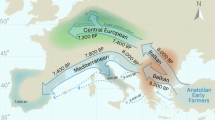Abstract
In a recent article Alexander et al.(1979) argue that intersocietal variation in human sexual dimorphism of stature can be explained by differing degrees of male- male competition for mates found in different types of societal marriage systems. In this paper we reexamine their data and suggest that their results may be more simply explained by reference to the latitude of the societies in their sample. Our investigation indicates that latitude has a significant influence on the degree of societal sexual dimorphism of stature. Peoples of the arctic region and the short peoples of the equatorial regions are less dimorphic in stature than midlatitude peoples. Thus, we conclude that the sociobiological hypothesis presented by Alexander et al.cannot alone explain the intersocietal variation in sexual dimorphism of stature and that environmental factors must be taken into account in the explanation of such variation.
Similar content being viewed by others
References
Alexander, R. D., Hoogland, J. L., Howard, R. D., Noonan, K. M., and Sherman, P. W. (1979). Sexual dimorphism and breeding systems in pinnipeds, ungulates, primates and humans. In Chagnon, N. A. and Irons, W. (eds.),Evolutionary Biology and Human Social Behavior: An Anthropological Perspective, Duxbury Press, North Scituate, Mass., pp. 402–435.
Birdsell, J. B. (1972).Human Evolution: An Introduction to the New Physical Anthropology, Rand McNally, Chicago.
Clutton-Brock, T. H., Harvey, P. H., and Rudder, B. (1977). Sexual dimorphism, socionomic sex ratio and body weight in primates.Nature 269: 796–800.
Evelth, P. B. (1975). Differences between ethnic groups in sex dimorphism of adult height.Annals of Human Biology 2: 35–39.
Evelth, P. B., and Tanner, J. M. (1976).World-wide Variation in Human Growth, International Biological Programme No. 8, Cambridge University Press, Cambridge.
Gray, J. P., and Wolfe, L. D. (1980). Height and sexual dimorphism of stature among human societies.American Journal of Physical Anthropology 53:441–456.
Greulich, W. W. (1951). The growth and developmental status of Guamanian school children in 1947.American Journal of Physical Anthropology 9: 55–70.
Hall, R. L. (1978). Sexual dimorphism for size in seven nineteenth century Northwest coast populations.Human Biology 50: 159–171.
Hamilton, M. E. (1975).Variation among five groups of Amerindians in the magnitude of sexual dimorphism of skeletal size. PhD dissertation, University of Michigan.
Kelso, J. A. (1970).Physical Anthropology: An Introduction. Lippincott, New York.
Roberts, D. F. (1978).Climate and Human Variability, 2nd ed. Cummings Publishing, Menlo Park, California.
Stini, W. A. (1969). Nutritional stress and growth: sex difference in adaptive response.American Journal of Physical Anthropology 31:417–426.
Stini, W. A. (1975). Adaptive strategies of human populations under nutritional stress. In Watts, E. S., Johnson, F. E., and Lasker, G. W. (eds.),Biosocial Interrelations in Population Adaptation, Mouton, The Hague, pp. 19–41.
Tobias, P. V. (1975). Anthropometry among disadvantaged peoples: Studies in Southern Africa. In Watts, F. E., Johnson, F. E., and Lasker, G. W. (eds.),Biosocial Interrelations in Population Adaptation, Mouton, The Hague, pp. 287–305.
Wolfe, L. D., and Gray J. P. (1982). A cross-cultural investigation into the sexual dimorphism of stature. In Hall, R. L. (ed.),Sexual Dimorphism in Homo Sapiens, Praeger, New York.
Author information
Authors and Affiliations
Additional information
This research was supported by a Faculty Research Grant from North Texas State University.
Rights and permissions
About this article
Cite this article
Wolfe, L.D., Gray, J.P. Latitude and intersocietal variation of human sexual dimorphism of stature. Hum Ecol 10, 409–416 (1982). https://doi.org/10.1007/BF01531194
Issue Date:
DOI: https://doi.org/10.1007/BF01531194




